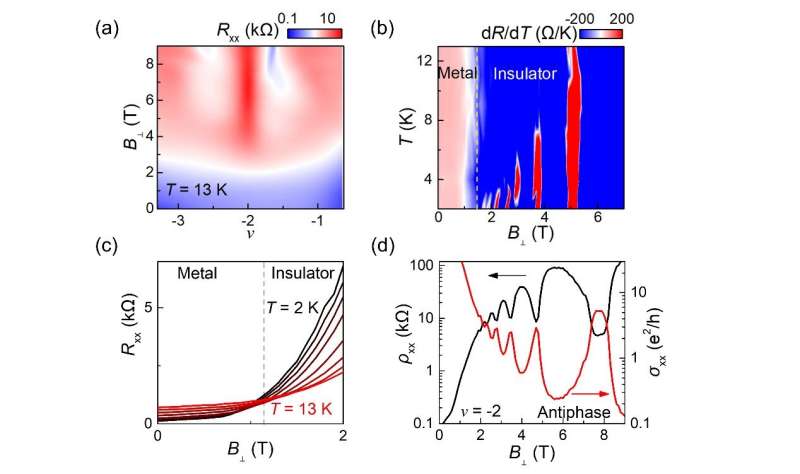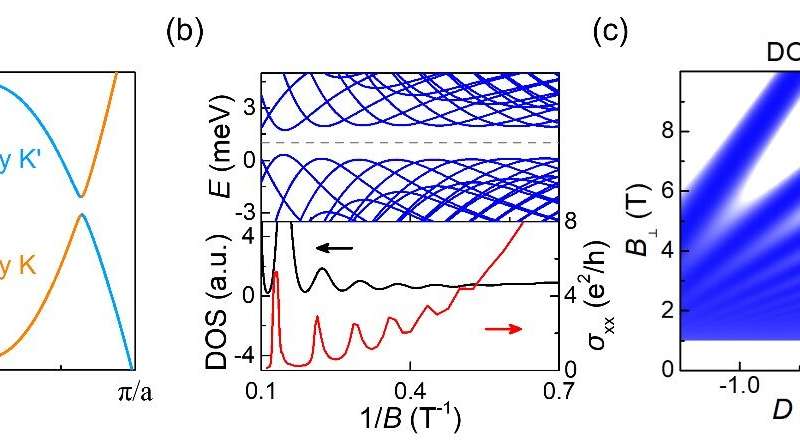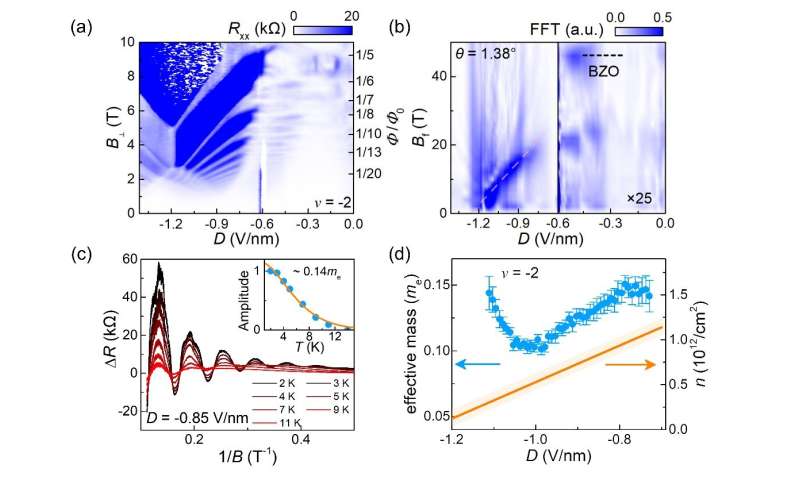
Quantum oscillations (QOs) of conductance in the magnetic field are widely observed in mesoscopic devices thanks to the Landau quantization, and thus QOs are commonly used as a powerful tool to measure the Fermi surface of metals. In contrast, QOs are usually absent for insulators due to the zero density of state in the gap.
A team led by Dr. Yang Wei and Dr. Zhang Guangyu from the Institute of Physics of the Chinese Academy of Sciences (CAS) reported the observation of anomalous quantum oscillations of correlated insulators in twisted double-bilayer graphene. Their paper, entitled "Quantum oscillations in field-induced correlated insulators of a moiré superlattice," was published in Science Bulletin.
Graphene-based moiré superlattices, which consist of two pieces of single or multilayer graphene stacked at a twisted angle, are known to host moiré flat bands and correlated states. A typical example is twisted double-bilayer graphene (2+2), whose band structure can be further tuned by electric field in addition to the twist angle, thus allowing tuning of flat bands and correlation strength in situ.
In this study, the researchers observed the spin-polarized and valley-polarized correlated insulators when the moiré bands were half filled in 2+2. With its highly tunable nature, 2+2 provides a new platform for discovering new exotic phases in the correlated insulating states.
 The team has long been devoted to exploring the quantum transport behavior in moiré superlattices. Previously, they found that new correlated insulators with valley polarizations appear at half fillings of energy bands in twisted double bilayer graphene, thanks to the orbital Zeeman effect in perpendicular magnetic field.
The team has long been devoted to exploring the quantum transport behavior in moiré superlattices. Previously, they found that new correlated insulators with valley polarizations appear at half fillings of energy bands in twisted double bilayer graphene, thanks to the orbital Zeeman effect in perpendicular magnetic field.To their surprise, they found that the resistance of correlated insulators in 2+2 oscillates periodically with the inverse of the magnetic field, similar to the Shubnikov de Haas oscillations in metal. The bulk insulating evidence of the QOs is revealed in the high oscillation amplitude of ~150 kΩ and its temperature dependence, as well as the antiphase behavior.
Moreover, the insulating QOs are strongly tunable by electric field. The carrier density extracted from the 1/B periodicity decreases almost linearly with D from -0.7 to -1.1V/nm, suggesting a reduced Fermi surface; the effective mass from the Lifshitz-Kosevich analysis depends nonlinearly on perpendicular electrical displacement field (D), reaching a minimum value of 0.1me at D = ~ -1.0V/nm.
 Quantum oscillations in a hybridized gap with band inversion. Credit: YANG Wei
Quantum oscillations in a hybridized gap with band inversion. Credit: YANG Wei Electrical field tunable quantum oscillations. Credit: YANG Wei
Electrical field tunable quantum oscillations. Credit: YANG Wei Quantum oscillations in a hybridized gap with band inversion. Credit: YANG Wei
Quantum oscillations in a hybridized gap with band inversion. Credit: YANG Wei Electrical field tunable quantum oscillations. Credit: YANG Wei
Electrical field tunable quantum oscillations. Credit: YANG Wei

To account for these anomalous phenomena, the researchers built a phenomenological inverted band model. With parameters extracted from experiments, density of states calculations from the model qualitatively reproduce the electric field tunable QOs of correlated insulators.
The observation of QOs of insulators in this study establishes a close connection to other strongly correlated systems such as Kondo insulators, topological insulators, and excitonic insulators, and it strongly suggests that more exotic phases are to be discovered in this system.
Visit:https://quantumtech.sfconferences.com/
Award Nomination: https://x-i.me/quawards
Award Registration: https://x-i.me/quareg2
Twitter:https://twitter.com/quantumtech23
Instagram:https://www.instagram.com/sahara_navi/




No comments:
Post a Comment